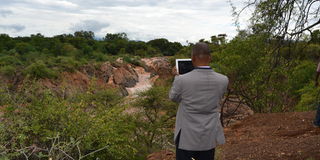Concerns as Sh425 billion High Grand Falls Dam to swallow villages

A local tourist takes a photo of Kibunka Fall in Tana River in Tharaka Nithi County. The fall will be swallowed by the proposed Sh425 billion High Grand Falls Dam.
Progress on the proposed Sh425 billion High Grand Falls Dam is good news for the rest of the country but not to thousands of residents of Tharaka Nithi, Kitui and Embu counties who will be relocated to make room for the project.
The dam is part of the Sh1.5 trillion Lamu Port-South Sudan-Ethiopia Transport (Lapsset) corridor projects that are expected to help Kenya achieve its Vision 2030.
The government of the United Kingdom has agreed to finance the dam as one of six Sh500 billion projects to be undertaken under a new Kenya-UK strategic partnership mainly targeting the agriculture and energy sectors.
The UK High Commission says work on the dam project in Tana River County will take between three and five years and will start in 2024.
Tharaka Nithi County residents and leaders have raised concerns about the proposed project, with some supporting and others opposing it.
Six locations
At least six locations in Tharaka constituency – Gituma, Maragwa, Kirukuma, Kamwathu, Kamarandi and Marimanti – will be completely or partially swallowed by the water.
A feasibility study conducted in 2012 by the Tana and Athi River Development Authority (TARDA) said at least 4,500 households would be affected in the three counties, with Tharaka Nithi the most affected.
Though some residents don’t want to move from their lands, the main concern is compensation.
Leaders and residents are worried that the government may not offer adequate compensation to allow affected families to acquire alternative land in their preferred areas.

Spiritual leaders from Tharaka, Gikuyu and Maasai communities gather at Kibuka Fall shrine in Tana River in Tharaka Nithi County to pray for rain in 2020. The elders are opposing the construction of Sh425 billion High Grand Falls Dam that would swallow the shrine.
Speaking during an earlier site visit, former TARDA CEO Steven Githaiga said the former proposed Chinese contractor had set aside Sh6 billion for resettling residents in the three counties.
He said the displaced would not get monetary compensation, noting that most of the people who were paid to move in order to allow the construction of the Masinga and Kiambere dams now live miserable lives as squatters.
Under initial plans, he said, those who would be displaced in Tharaka Nithi for the High Grand Falls Dam were to be resettled in Tsekulu, Kitui County, but Tharaka Nithi politicians rejected the idea of moving their people to a different county.
Monetary compensation
Speaking to the Nation on Wednesday, Tharaka MP Gitonga Murugara said that though he supports the proposed dam, those to be affected must be given adequate monetary compensation and not resettlement.
“People must be compensated with enough money so that they can choose where they would like to resettle and not be forced into a settlement scheme as earlier communicated,” Mr Murugara said.
He said the 2012 feasibility study is outdated and that another one should be conducted in order to capture the current situation for appropriate compensation.
The lawmaker added that apart from compensation on physical properties like land and buildings, there should be communal reparations because of the psychological effect the relocation will have on affected residents.
He said all public institutions that will be affected, such as schools and hospitals, must also be established in resettlement areas.
Because the dam will benefit counties such as Tana River, which are on the lower side, he said the government will have to use electricity to pump water into big tanks on hilltops in order to irrigate the whole of Tharaka constituency.
“There must be enough public participation in order to clearly explain to the people the progress and not keep them in the dark, only to be pushed away,” he said.
On employment, Mr Murugara said local leaders will seek to have a memorandum of understanding with the contractor and the government’s implementing agency so that locals can also benefit directly through employment.
Ancestral attachment
Mr Simon Ndonco, president of the Society for Alternative Learning and Transformation (SALT), which embraces positive cultural practices in the Tharaka community, opposes relocating people from their ancestral land.
He argues that locals are attached to homesteads where they buried the remains of their ancestors.
He said the Kibuuka Falls in Tana River is a sacred place where the Tharaka community goes to offer sacrifices to their gods and would be swallowed and destroyed by the dam.
“When there are calamities such as drought and disease outbreaks, Tharaka community elders slaughter a goat at the Kibuuka Falls and the problem ends and this is one of the reasons we are opposed to the dam,” Mr Ndonco said.
Mr Julius Kamwara, 82, a resident of Gituma location, wondered how he would relocate to another place in his advanced age and get used to the new area.
“Most of the villages are made of extended families and people from one clan and if relocated, it will not be possible to resettle them together again,” Mr Kamwara said.
The High Grand Falls Dam will be Kenya’s second-largest infrastructure project after the Nairobi-Mombasa standard gauge railway (SGR) and will irrigate 400,000 hectares and generate 1,000MW of electricity.
It will be established under a public-private partnership. The agreement was reached on Monday following talks between President William Ruto and UK Prime Minister Rishi Sunak in Sharm el-Sheikh, Egypt.





